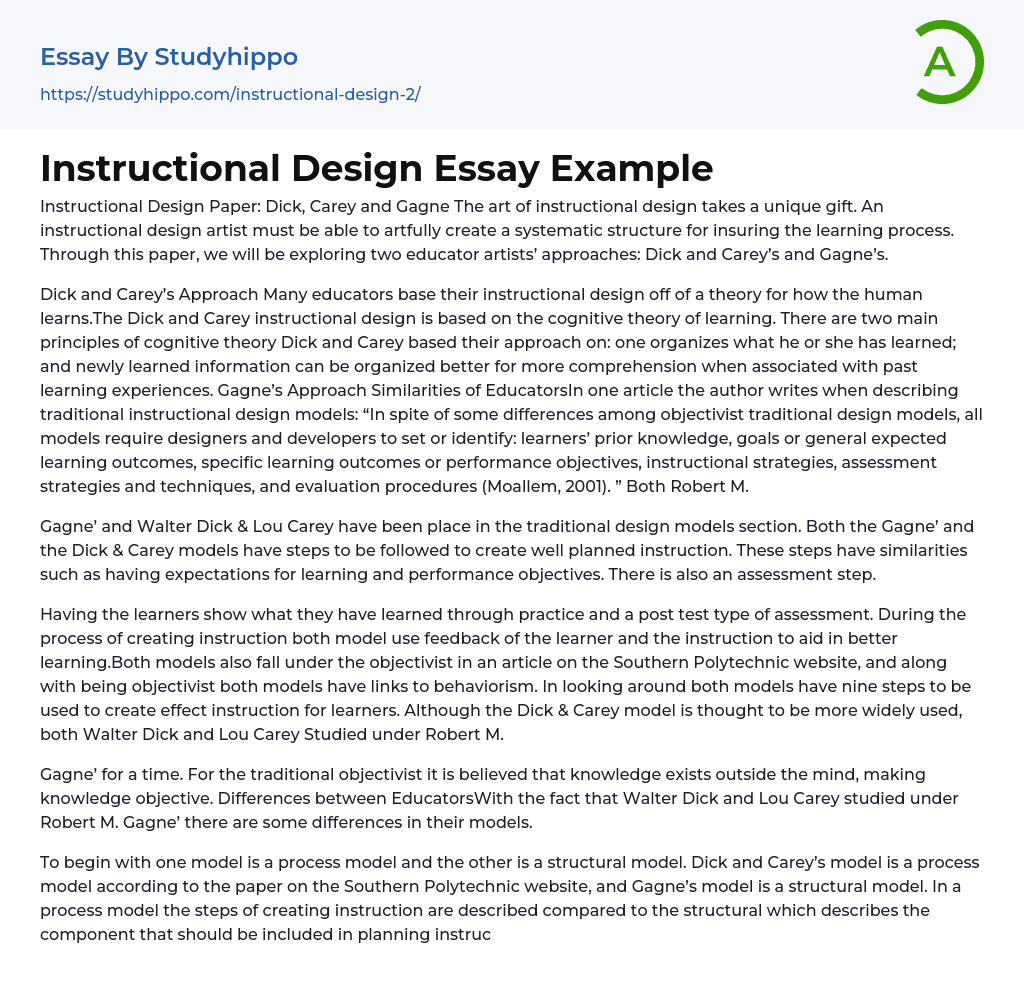Exploring two artist educators' approaches, Dick and Carey's and Gagne's, to the art of instructional design. This process requires a unique gift as instructional design artists must artfully create a systematic structure for ensuring effective learning.
Dick and Carey and Gagne's approaches to instructional design are rooted in cognitive theory. Dick and Carey based their approach on two main principles of the theory: organizing learned information and improving comprehension through association with past learning experiences. Meanwhile, Gagne's approach shares similarities with traditional instructional design models, requiring identification of learners' prior knowledge, general expected learning outcomes, specific performance objectives, instructional and assessment strategies, and evaluation procedures (Moallem, 2001).
In the category of traditional design models, both the Gagne’ and Walter Dick & Lou Carey models share common steps for creating well-planned inst
...ruction. These steps include defining learning expectations, setting performance objectives, and incorporating an assessment stage.
The aim is for learners to demonstrate their learning through practice and assessment using a post test. Both models- model use and feedback- can aid in better learning during the instruction creation process. Objectivist principles are followed, and both models are related to behaviorism, according to an article on the Southern Polytechnic website. Furthermore, both models consist of nine steps for creating effective instruction. Despite the Dick & Carey model being more popular, Walter Dick and Lou Carey were both students of Robert M.
There are differences in the models of Walter Dick and Lou Carey, who both studied under Robert M. Gagne'. While traditional objectivists believe that knowledge is objective and exists outside the mind, Gagne's ideas challenge this belief.
According to the Southern Polytechnic website, there are two type
of models: process and structural. The Dick and Carey model falls under the category of process models while Gagne’s model is a structural one. In a process model, the focus is on defining the steps for creating instruction, whereas in a structural model, the emphasis is on identifying the components necessary for planning instruction for learners. The initial step in the Dick and Carey model involves defining instructional goals while Gagne’s model starts by gaining learners’ attention.
Attention and understanding of instructional goals are both important for starting the planning process, but in different ways depending on the model used. The Dick and Carey model includes a step for revising instruction, which is absent from the Gagne’ model. The Gagne’ model includes a step for activating short term memory to link new information to prior knowledge while the Dick and Carey model looks at entry behaviors without specific regard to short term memory. The Gagne’ model features skill practice and feedback, whereas the Dick and Carey model does not have a feedback step in the flow chart, but includes revision opportunities and formative/summative evaluations. The Dick and Carey model involves some bouncing between steps, while the Gagne’ model is a more continuous flow of steps.
Today, the impact of Dick and Carey and Gagne on instructional design is significant. Gagne's nine instructional events provide the optimal conditions for learning and recognize the role of technology in the learning process. As a leading researcher and contributor to systematic training, Gagne's ideas can also be applied effectively to e-learning (Kruse, 2001).
Gagne, a behaviorist, identifies nine steps for successfully completing an e-learning task. His training focuses on achieving desired outcomes
or behaviors (Kruse, 2001). The positive impact of his work demonstrates how an event can boost an individual's cognitive processes. His book, The Conditions of Learning, published in 1965, identifies the mental conditions necessary for learning (Kruse, 2001).
Robert Gagne and Dick and Chaney have made significant contributions to instructional design, influencing the field in positive ways. By following Gagne’s ideas, one can produce a well-informed research paper, while educators can present the material effectively to help students learn positively. Both educators have developed a nine-stage process for achieving success in instructional design and education. Overall, their renowned work has greatly impacted the field of instructional design.
The educators serve as role models for those who aspire to excel in teaching and create a classroom environment where students can gain significant knowledge. (Gagne, R. (1985). Conditions of Learning. Retrieved October 30, 2008 from http://tip.)
The website psychology.org has a page called "gagne.html" as cited by Kevin Kruse in 2001.The article "An Introduction to Gagne's Nine Events of Instruction" can be found at http://www.e-learningguru.com/articles/art3_3 and was accessed on October 30, 2008.
Lee, Hee-Sun and Lee, Soo-Young (1996) retrieved information regarding the Dick and Carey Model from http://www on October 30, 2008.
Moallem, M. (2001). umich.edu/~ed626/Dick_Carey/dc.html.
Utilizing Constructivist and Objectivist Learning Theories for the Development of a Web-based Course: Consequences of Implementation. Southern Polytechnic's Educational Technology & Society, Volume 4 Issue 3. Focus on Learning Theories and Instructional Design.
The web address www.spsu.edu/htc/hughes/papers/interface.htm was accessed on November 1, 2008. The information was contained within a paragraph tag.
- Email essays
- Hypertext Transfer Protocol essays
- Marshall Mcluhan essays
- Virtual Learning Environment essays
- Web Search essays
- Etiquette essays
- Mainstream essays
- Vodafone essays
- Web Search Engine essays
- Interpretation essays
- Plagiarism essays
- Analogy essays
- Learning English essays
- Android essays
- Application Software essays
- Benchmark essays
- Computer Network essays
- Computer Programming essays
- Computer Security essays
- Computer Software essays
- Cryptography essays
- Data collection essays
- Data Mining essays
- Graphic Design essays
- Information Systems essays
- Internet essays
- Network Security essays
- Website essays
- World Wide Web essays
- Coaching essays
- Critical Thinking essays
- homework essays
- Learning essays
- Library essays
- Listening essays
- Literacy essays
- Mentor essays
- Physical Education essays
- Project essays
- Reading essays
- Research essays
- Sex Education essays
- Social Studies essays
- Standardized Testing essays
- Study Plan essays
- Teaching essays




